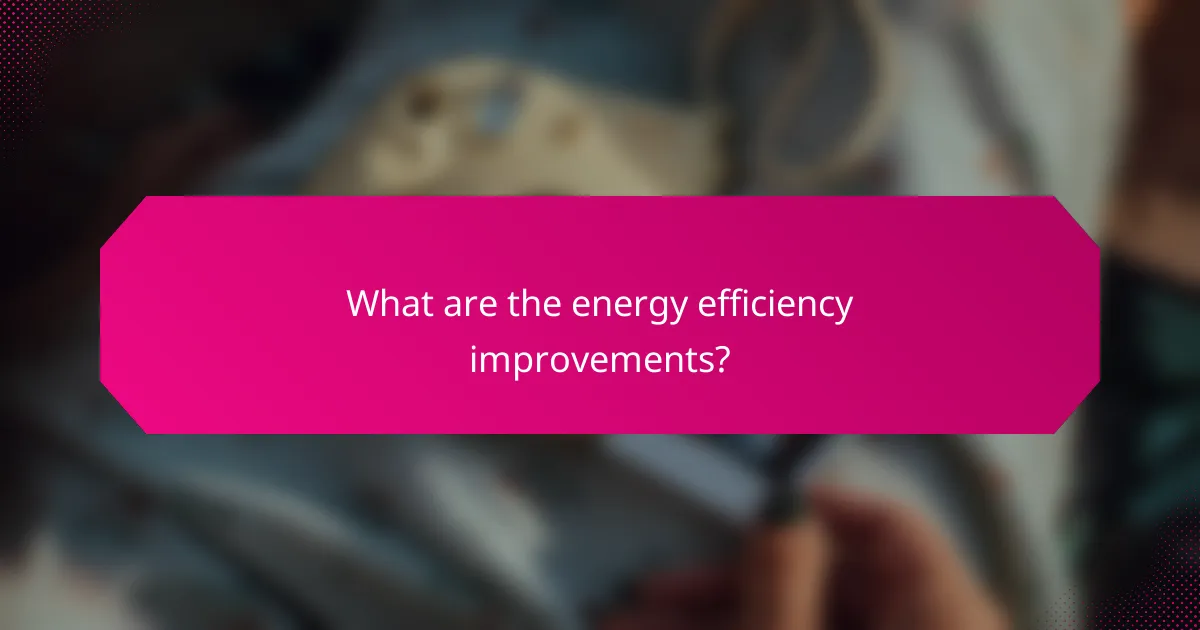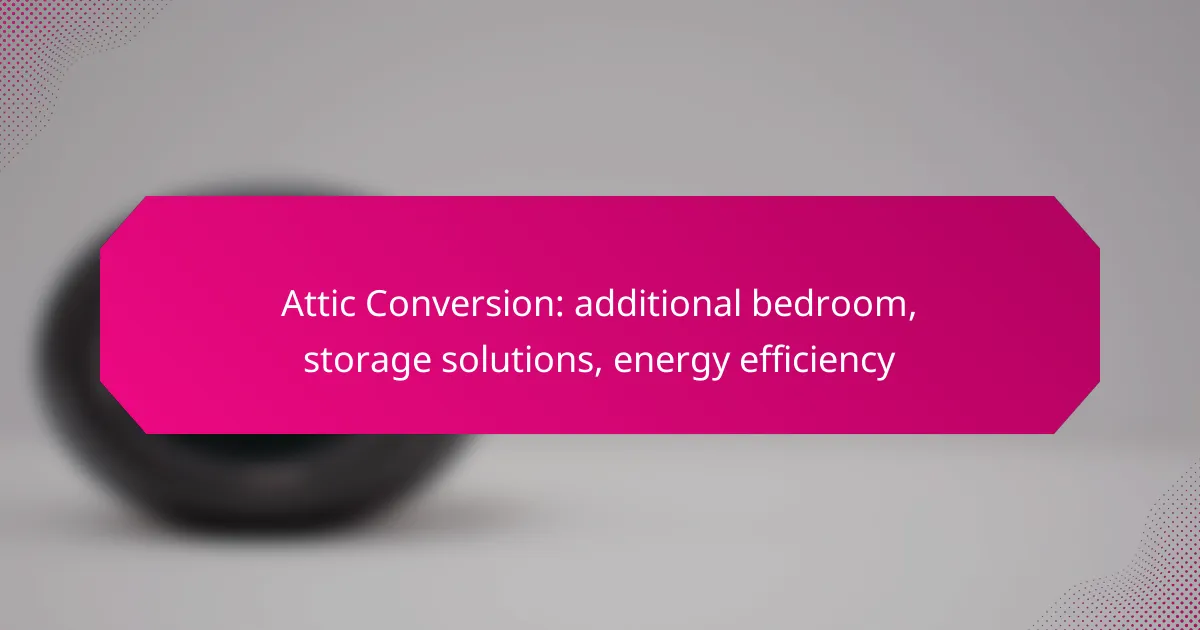Converting your attic can significantly enhance your home by providing additional living space, such as an extra bedroom, while also offering innovative storage solutions and improved energy efficiency. This transformation not only maximizes your property’s potential but can also increase its overall value. With careful planning and consideration of design and structural integrity, your attic can become a functional and inviting area tailored to your needs.

What are the benefits of attic conversion in the UK?
Attic conversion in the UK offers several advantages, including the creation of additional living space, increased property value, and improved energy efficiency. These benefits make it an attractive option for homeowners looking to maximize their property’s potential.
Additional bedroom space
Converting an attic can provide a valuable extra bedroom, which is especially beneficial for growing families or those needing guest accommodations. This space can be designed to meet specific needs, whether as a children’s room, a home office, or a guest suite.
When planning an attic conversion, consider the layout and access. Ensure that the stairs leading to the attic are safe and compliant with building regulations. Adequate headroom is essential, so check the roof pitch and consider dormer windows to enhance space and light.
Increased property value
Adding an attic conversion can significantly boost your home’s market value, often yielding a return on investment of around 20-30%. This increase is particularly notable in urban areas where space is at a premium.
To maximize the value added, ensure that the conversion is completed to a high standard and fits well with the overall style of the home. Engaging with local estate agents can provide insights into the potential value increase specific to your area.
Enhanced energy efficiency
Attic conversions can improve a home’s energy efficiency by incorporating modern insulation and energy-efficient windows. Proper insulation helps maintain comfortable temperatures, reducing heating and cooling costs.
When converting your attic, consider using sustainable materials and energy-efficient systems. This not only benefits the environment but can also qualify for various government incentives or grants aimed at improving energy efficiency in homes across the UK.

How to plan an attic conversion?
Planning an attic conversion involves careful consideration of structural integrity, necessary permissions, and design choices. A well-executed plan can transform your attic into a functional space, whether for an additional bedroom or storage solutions.
Assess structural integrity
Before starting an attic conversion, it’s crucial to evaluate the structural integrity of your home. This includes checking the condition of beams, joists, and the roof to ensure they can support the additional weight and usage.
Engaging a structural engineer can provide insights into necessary reinforcements or modifications. Common issues may include inadequate support or signs of water damage, which should be addressed before proceeding.
Determine planning permissions
Obtaining the correct planning permissions is essential for a successful attic conversion. Depending on your location, you may need to apply for full planning permission or a certificate of lawful development.
Check local regulations to understand what is required. In many areas, conversions that do not alter the roofline may fall under permitted development rights, while others may need detailed applications. Consulting with your local council can clarify these requirements and help avoid potential legal issues.

What are the costs associated with attic conversion?
The costs associated with attic conversion can vary significantly based on factors such as location, design complexity, and materials used. Generally, homeowners should expect to invest a substantial amount, often ranging from tens of thousands to over a hundred thousand dollars, depending on the scope of the project.
Average conversion costs in London
In London, the average cost for an attic conversion typically falls between £30,000 and £70,000. This range can fluctuate based on the size of the attic, the type of conversion (such as a dormer or mansard), and any necessary structural changes. Additionally, planning permissions and local regulations may add to the overall expense.
Homeowners should also consider potential additional costs, such as those for interior finishes, electrical work, and plumbing if a bathroom is included. It’s wise to budget for unexpected expenses, which can arise during construction.
Cost breakdown by materials
The cost of materials for an attic conversion can significantly impact the overall budget. Common materials include insulation, roofing, flooring, and drywall, with costs varying based on quality and type. For example, high-quality insulation can range from £20 to £40 per square meter, while flooring options can vary from £30 to £100 per square meter depending on the chosen material.
Additionally, structural elements such as beams and supports may require specialized materials, which can further increase costs. It’s essential to consult with contractors to get accurate estimates based on your specific project needs and to ensure compliance with local building regulations.

What are the design options for attic conversions?
Attic conversions offer various design options that can enhance your living space, providing additional bedrooms or storage solutions while improving energy efficiency. Key considerations include layout, insulation, and compliance with local building regulations.
Loft bedroom designs
Loft bedrooms can be designed in multiple styles, from cozy nooks to spacious retreats. Considerations include ceiling height, window placement, and access, such as stairs or ladders. Popular designs often incorporate skylights to maximize natural light and create an airy atmosphere.
When planning a loft bedroom, ensure the space meets local building codes, especially regarding egress windows for safety. Additionally, think about soundproofing and insulation to maintain comfort and privacy.
Storage solutions in attic spaces
Attics can provide excellent storage solutions if designed effectively. Built-in shelves, cabinets, and under-eave storage can help maximize space while keeping it organized. Consider using lightweight materials and modular designs for flexibility.
To optimize storage, categorize items and use clear bins or labels for easy access. Avoid overloading the space, as this can lead to safety hazards. Regularly assess stored items to keep the attic functional and clutter-free.

What are the energy efficiency improvements?
Energy efficiency improvements in an attic conversion can significantly reduce heating and cooling costs while enhancing comfort. Key upgrades typically include better insulation, energy-efficient windows, and proper ventilation.
Insulation options
Effective insulation is crucial for maintaining a comfortable temperature in your converted attic. Common insulation materials include fiberglass batts, spray foam, and cellulose, each offering varying R-values that indicate thermal resistance. Aim for an R-value of at least 30 to 49, depending on your climate zone.
When selecting insulation, consider factors like moisture resistance and ease of installation. For instance, spray foam provides excellent air sealing but may be more expensive than fiberglass batts. Ensure that your insulation covers all areas, including sloped ceilings and around any ducts.
Energy-efficient windows
Installing energy-efficient windows can drastically improve the thermal performance of your attic space. Look for windows with a low U-factor, which measures heat transfer, and a high Solar Heat Gain Coefficient (SHGC) to minimize heat gain in warmer months. Double or triple glazing is often recommended for optimal insulation.
Consider window placement and shading as well. South-facing windows can maximize passive solar heating in winter, while overhangs or awnings can reduce heat gain in summer. Additionally, ensure proper sealing and installation to prevent drafts, which can undermine energy efficiency.

What are the common challenges of attic conversion?
Attic conversions often face challenges such as compliance with building regulations, ensuring safe access, and optimizing space for storage or additional bedrooms. Addressing these issues early can streamline the conversion process and enhance the final outcome.
Building regulations compliance
Compliance with building regulations is crucial for any attic conversion project. These regulations typically cover aspects such as structural integrity, fire safety, and insulation standards. Homeowners should consult local building codes to ensure their plans meet all necessary requirements.
Common regulations may include minimum ceiling heights, window sizes for natural light and ventilation, and fire escape routes. Engaging a qualified architect or builder can help navigate these requirements effectively, reducing the risk of costly modifications later.
Access and staircase design
Designing safe and functional access to the attic is essential. A well-planned staircase not only provides safety but also enhances the overall usability of the converted space. Considerations include the staircase’s location, width, and angle, which should comply with local building codes.
For smaller attics, a spiral or compact staircase may be suitable, while larger spaces might accommodate a traditional staircase. Ensure the design allows for easy movement of furniture and personal items to maximize the attic’s potential as a bedroom or storage area.

How to choose a contractor for attic conversion?
Choosing a contractor for an attic conversion involves assessing their experience, reliability, and understanding of local building regulations. Look for professionals who specialize in attic renovations and can provide clear estimates and timelines.
Questions to ask potential contractors
When interviewing potential contractors, ask about their experience with attic conversions specifically. Inquire about past projects, references, and how they handle challenges that may arise during the renovation process.
Additionally, discuss their approach to project management, including timelines and communication methods. It’s also wise to ask about their warranty policies and how they handle post-completion issues.
Checking contractor credentials
Verify that the contractor holds the necessary licenses and insurance required for attic conversions in your area. This typically includes liability insurance and worker’s compensation coverage to protect you from potential liabilities.
Check for any certifications or memberships in professional organizations, which can indicate a commitment to quality and ongoing education. Online reviews and ratings can also provide insights into their reputation and reliability.
